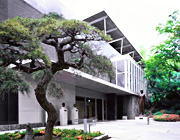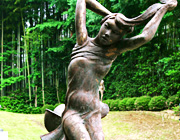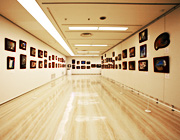Kasama Nichido Museum of Art:English

The Kasama Nichido Museum of Art of the Nichido Art Foundation was opened on November 11, 1972. The museum was established by the founder of Galerie Nichido, Jin Hasegawa and his wife Rinko. The land on which the museum stands is the site where the Hasegawa Family estate has stood for generations, located roughly in the center of Kasama City, Ibaraki Prefecture, and occupying the western edge of the Sashiroyama Castle Remains Park.

The Kasama Nichido Museum was established in commemoration of the 45th anniversary of the founding of Galerie Nichldo, Japan's first commercial gallery, by Jin Hasegawa and his wife Rinko on the occasion of their golden wedding anniversary. In 1997, the 25th anniversary of the museum's founding and the 70th anniversary of the founding of Galerie Nichido, the former main building of the museum, which was dedicated as the founder's memorial building, has now been rebuilt and laid out to serve as a comprehensive museum facility. Throughout their lives, the museum founders held the ideal of "bringing outstanding art to a larger audience." We have carried on this tradition to this day and hope to make it our guiding principle as we work to make what contribution we can to the Japanese art world.

This Main Building will be dedicated to the permanent display of a wide range of works from the Impressionists and Ecole de Paris painters whose influence on modern Japanese artists was so great, to the drawings of Japanese artists of the modern period, and to it has been added a Jin and Rinko Hasegawa Memoriai Room.
In the adjoining outdoor sculpture garden numerous works of sculpture and busts of the modern masters stand in beautiful harmony with their surroundings.
The West Wing, which stands next to the Main Building, is dedicated to our collection of the works of contemporary Japanese artists as well as a collection of artist palette paintings. These palette paintings, with their special research value as keys to the actual painting methods of the artists, constitute one of this museum's most unique and valuable assets.
The East Wing of the museum, which in the past has been used for exhibitions from the permanent collection and special exhibitions, will now be used specifically for a more substantial schedule of special exhibitions that we hope to bring to our viewing public.
In the nearby hills about two kilometers from the museum Is the Shunpu Banri So. Here visitors can enjoy the thatched-roof Edo Period farm residence loved by Rosanjin Kitaoji and a nagaya-mon style gate from a samurai residence of the same period standing in a large garden area. Together, the Main Building, East Wing, West Wing, the Shunpu Banri So and the Outdoor Sculpture Garden form an integrated museum that uses all the facilities in an organic relationship for the display of a wide range of art works.
Although Our powers are limited, we intend to redouble our efforts to make meaningful and constructive use of these facilities, and in this task we ask for your continued support and advice.
Finally, we would like to express our deep appreciation to all the artists and art lovers who have donated or entrusted this museum with valuable works of art and related materials of artistic importance.